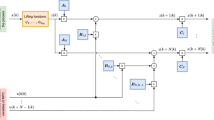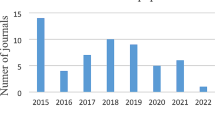Abstract
This paper proposes a generalized robust predictive control approach based on 3rd order S-PARAFAC Volterra Model. The main idea is to use the predictive control law based on the latter model with taking into account the parameter and operation uncertainties resulting from the measurement noise and the robust identification technique named Unknown But Bounded Error (UBBE). One of the advantages is the convexity of the objective function with respect to the parameter uncertainty set. The min-max optimization problem becomes thus simpler, by minimizing the objective function in the worst-case only over the set of uncertain models. This work proposes a new generalized nonlinear robust control algorithm dedicated for uncertain processes. In this algorithm we optimize a quadratic criterion and take into account the physical and geometrical constraints due to parameter uncertainties. The performances of this work are illustrated and validated on a benchmark as a continuous stirred-tank reactor system (CSTR) and on an experimental 2-DoF helicopter system.
Similar content being viewed by others
References
A. A. H. Salah, T. Garna, J. Ragot, and H. Messaoud, “Synthesis of a robust controller with reduced dimension by LSDP-technique and decomposition based on Laguerre functions,” Tansactions of the Institute of Measurement and Control, vol. 38, no. 10, pp. 1236–1260, 2016.
D. McFarlane and K. Glover, “Robust controller design using normalized coprime factor plant descriptions,” Lecture Notes in Control and Information Sciences, Springer-Verlag, Berlin, 1990.
A. L. D. Franco, H. Bourles, and E. R. de Pieri, “Robust nonlinear control associating robust feedback linearization and H∞ control,” IEEE Transactions on Automatic Control, vol. 51, no. 7, pp. 1200–1207, 2006.
H. Guillard and H. Bourles, “Robust feedback linearization,” Proceedings of the 14th International Symposium on Mathematical Theory of Networks and Systems, Perpignan, France, 2000.
F. J. Doyle, Robustness Properties of Nonlinear Process Control and Implications for the Design and Control of a Packed Bed Reactor, Ph.D. thesis, California Institute of Technology, CA, USA, 1991.
C. Liu, H. Li, J. Gao, and D. Xu, “Robust self-triggered min-max model predictive control for discrete-time nonlinear systems,” Automatica, vol. 89, pp. 333–339, 2018.
J. H. Lee and B. L. Cooley, “Min-max predictive control techniques for a linear state-space system with a bounded set of input matrices,” Automatica, vol. 36, no. 3, pp. 463–473, 2000.
R. Heydari and M. Farrokhi, “Robust model predictive control of biped robots with adaptive on-line gait generation,” Int. J. of Control, Automation and Systems, vol. 15, no. 1, pp. 329–344, 2017.
H. Messaoud and G. Favier, “Recursive determination of parameter uncertainly intervals for linear models with unknown but bounded errors,” Proc. of IFAC Symp. On system identification, Denmark, pp. 365–370, 1994.
K. Bouzrara, A. Mbarek, and T. Garna, “Nonlinear predictive controller for uncertain process modelled by GOBF-Volterra models,” Int. J. Modelling, Identification and Control, vol. 19, no. 4, pp. 307–322, 2013.
A. Y. Kibangou, G. Favier, and M. M. Hassani, “Iterative optimization method of GOB-Volterra filters,” Proc. of IFAC World Congress, Prague, Czech Republic, 2005.
G. H. C. Oliveira, W. C. Amaral, G. Favier, and G. A. Dumont, “Constrained robust predictive controller for uncertain processes modeled by orthonormal series functions,” Automatica, vol. 36, no. 4, pp. 563–572, 2000.
G. Favier, A. Y. Kibangou, and T. Bouilloc, “Nonlinear system modeling and identification using Volterra-PARAFAC models,” Int. J. of Adaptive Control and Signal Processing, vol. 20, no. 1, pp. 30–53, 2012.
A. Khouaja and G. Favier, “Identification of SVD-PARAFAC based third-order Volterra models using an ARLS algorithm,” Proc. of IFAC World Congres, Prague, Czech Republic, 2005.
A. Khouaja, T. Garna, J. Ragot, and H. Messaoud, “Robust predictive controller for nonlinear uncertain process based on S-PARAFAC Volterra models,” Int. J. of Advanced Manufacturing Technology, vol. 90, pp. 5–8, pp. 2309–2323, 2016.
A. Khouaja, T. Garna, J. Ragot, and H. Messaoud, “Constrained predictive control of a SISO nonlinear system based on third-order S-PARAFAC Volterra models,” Transactions of the Institute of Measurement and Control, vol. 39, no. 6, pp. 907–920, 2016.
S. H. Mo and J. P. Norton, “Fast and robust algorithm to compute exact polytope parameter bounds,” Mathematics and Computers in Simulation, vol. 32, no. 5–6, pp. 481–493, 1990.
G. Favier and G. C. Olivera, “Commande prédictive robuste basée sur une modélisation de Laguerre,” Conception de Commandes Robustes, Paris, Hermés, 2002.
A. D. Belegundu and J. S. Arora, “A recursive quadratic programming method with active set strategy for optimal design,” Int. J. Numerical Methods in Engineering, vol. 20, no. 5, pp. 803–816, 1984.
H. Demuth, M. Beale, and M. Hagan, Neural Network Toolbox 5, User’s Guide, The MathWorks, Natick, MA, 2007.
Author information
Authors and Affiliations
Corresponding author
Additional information
Publisher’s Note Springer Nature remains neutral with regard to jurisdictional claims in published maps and institutional affiliations.
Recommended by Associate Editor Ning Sun under the direction of Editor Jay H. Lee.
Anis Khouaja was born in 1975 in Sousse in Tunisia. In 2000, he received his B.Eng. degree from the National Engineering School of Monastir (ENIM) in Tunisia. Respectively in 2001 and 2005, he received an M.Sc. and Ph.D. degrees from the University of Nice Sophia Antipolis in France. He received in 2016, a Habilitation degree in Electrical Engineering from the University of Sousse in Tunisia. Currently, he is an Associate Professor in the Electrical Engineering Department, High Institute of Applied Science and Technology of Sousse, Tunisia. He is also a member of the LARATSI Laboratory of the Engineering National School of Monastir in Tunisia. His research interests include system modeling and identification, nonlinear system theory and robust predictive control.
Tarek Garna was born in 1978 in Sousse, Tunisia. He received his Ph.D. degree in Automatic Control from the National Engineering School of Monastir, in 2009. He received a Habilitation degree in Electrical Engineering from the University of Sousse in Tunisia, in June 2015. He is presently an Assistant Professor at the Higher Institute of Applied Sciences and Technology of Sousse and a member of the laboratory LARATSI. His research interests include system modeling and identification, nonlinear system theory and robust predictive control.
Rights and permissions
About this article
Cite this article
Anis, K., Tarek, G. An Improved Robust Predictive Control Approach Based on Generalized 3rd Order S-PARAFAC Volterra Model Applied to a 2-DoF Helicopter System. Int. J. Control Autom. Syst. 19, 1618–1632 (2021). https://doi.org/10.1007/s12555-019-0936-1
Received:
Revised:
Accepted:
Published:
Issue Date:
DOI: https://doi.org/10.1007/s12555-019-0936-1




